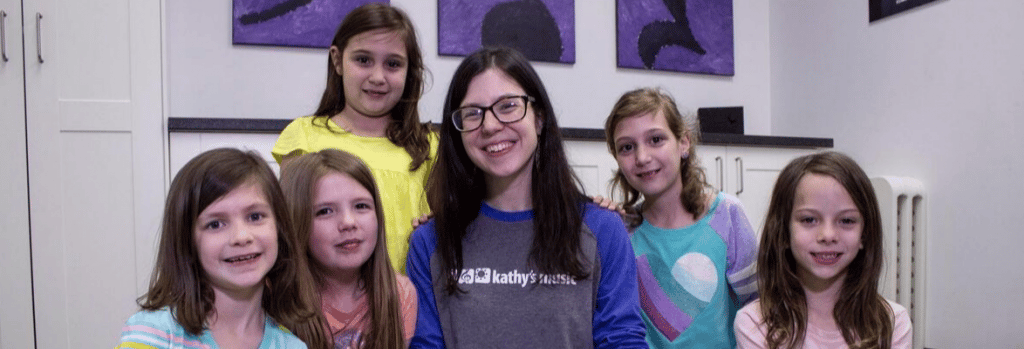
By Christin Cooper
As students across our studios are setting and achieving their Summer Goals, we are highlighting some of the ways our group lesson suite orients toward musical milestones to establish a strong foundation for beginners. This month, we are learning more about the milestones students achieve in Studio Singers!
The First Three Notes Just Happen to Be…. Do, Re, Mi
Creative activities are so central to our group class curriculum because they provide an outlet for each child to contribute meaningfully. Students engaged in creative activities are operating from a place of engagement and ownership; their participation is active, not passive. One of the best ways to encourage creativity at this age is through improvisation. In Studio Keys, students improvise on the black keys using the pentatonic scale. Students
Our Studio Singers program emphasizes a well-rounded introduction to singing with an emphasis on musical literacy, healthy vocal technique, and building community. Throughout the first year, students learn to find their head voices, demonstrate proper singing posture, and refine their breath technique. Through a variety of rote and reading methodologies, students improve their aural skills, practice sight-reading, and acquire a solid theoretical foundation that will equip them for further study. Singing within a supportive and encouraging community of peers builds confidence and positive reinforcement of learning through social bonds.
As a pillar of our educational mission, musical literacy factors into many of the milestones voice students work toward. Whether it’s sight-singing with solfege syllables, or reading the lyrics to a familiar folk song, students practice the transferrable skills of tracking visually on a page from left to right, applying symbol to sound, identifying components of the staff, and learning to audiate musical intervals. Furthermore, vocalists rarely read sheet music printed with their part only. These students master the unique and complex task of isolating and reading a single line amidst multiple vocal and instrumental parts written on the same page.
What’s your EQ?
Memorization, while occasionally expected of instrumentalists, is an expected performance tradition when it comes to singing. In addition to the cognitive and musical benefits of memorization, young singers have a special opportunity to explore their emotions in a healthy and safe way when they sing from memory. Without the physical barrier of a folder, instrument, or music stand, singers connect with their audiences directly through eye contact, facial expression, movement, and language. These experiences in healthy emotional expression resonate far beyond the stage, as study after study has shown the crucial role social and emotional competencies play in promoting supportive communities and resilient children.

Fostering a Musical Community
Children create strong social bonds when they encourage, support, and help each other along the path of achieving each milestone. This is why we encourage students to continue onto a second year with the same cohort from Studio Singers Year 1. Students will continue to strengthen their part-singing skills, moving from polyphonic textures to simple homophony in two or three parts. They will practice singing with solfege in a wider variety of keys, filling their aural memory banks with multiple scales and modes. When it’s time to move on to private study, these musical explorers will confidently embark on their first solo flight with the support of their peers and the skillset to help them soar!
